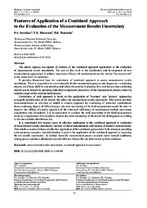| dc.contributor.author | Serenkov, P. S. | |
| dc.contributor.author | Hurevich, V. L. | |
| dc.contributor.author | Tolochko, T. K. | |
| dc.coverage.spatial | Минск | ru |
| dc.date.accessioned | 2020-03-17T07:29:08Z | |
| dc.date.available | 2020-03-17T07:29:08Z | |
| dc.date.issued | 2020 | |
| dc.identifier.citation | Serenkov, P. S. Features of Аpplication of a Сombined Аpproach to the Еvaluation of the Мeasurement Results Uncertainty = Особенности применения комбинированного подхода к оцениванию неопределённости результатов измерений / P. S. Serenkov, V. L. Hurevich, Т. К. Тоlochko // Приборы и методы измерений : научно-технический журнал. – 2020. – Т. 11, № 1. – С. 60-69. | ru |
| dc.identifier.uri | https://rep.bntu.by/handle/data/68592 | |
| dc.description.abstract | The article exposes description of features of the combined approach application to the evaluation of measurement results uncertainty. The aim of this work is the justification and development of new science-driven approaches to achieve maximum efficacy of measurements on the criteria "accuracy/costs" at the stated level of confidence. It provides theoretical base for correctness of combined approach to assess measurement results uncertainty. There is proposition to conventionally divide measurement process into fragments – combining objects, each from shall be considered as individual element for evaluation. It is well known that combining objects can be formed by grouping individual components (resources) of the measurement process either via separate stages of the measurement process. Correctness of such approach is based on the application of "resource" and "process" approaches as regards identification of the factors that affect the measurement results uncertainty. This article provides recommendations on selection of model or empiric approach for evaluating of particular contributions from combining objects of different types into total uncertainty of the final measurement result. In order to improve the validity of empiric approach of the criteria of sufficiency of measurement method uncertainty examination was formulated. It is recommended to evaluate the total uncertainty of the final measurement result by complexation of evaluations of particular total uncertainty of the results for all fragments according to the uncertainties distribution law. It is determined two typical cases of effective application of the combined approach to evaluation of measurement results uncertainty: method of direct measurements and method of indirect measurements. This article considers features of effective application of the combined approach for both situations providing corresponding examples. Special attention is paid to the application of the combined approach to assessing the test results uncertainty. As distinct from the measurement process realized under normal conditions, testing process includes additional external influence factors that are determined by test conditions. | ru |
| dc.language.iso | en | ru |
| dc.publisher | БНТУ | ru |
| dc.title | Features of Аpplication of a Сombined Аpproach to the Еvaluation of the Мeasurement Results Uncertainty | ru |
| dc.title.alternative | Особенности применения комбинированного подхода к оцениванию неопределённости результатов измерений | ru |
| dc.type | Article | ru |
| dc.identifier.doi | 10.21122/2220-9506-2020-11-1-60-69 | |
| local.description.annotation | Рассмотрены особенности эффективного применения комбинированного подхода к оцениванию неопределённости результатов измерений. Целью данной работы являлось обоснование и развитие новых наукоёмких подходов по достижению максимальной эффективности измерений по критерию «точность/трудоёмкость» при заданной степени доверия. Теоретически обоснована корректность комбинированного подхода к оцениванию неопределённости результатов измерений. Предложено процесс измерения условно делить на фрагменты – объекты комбинирования, каждый из которых следует рассматривать как самостоятельный элемент оценивания. Установлено, что объекты комбинирования могут быть сформированы путём группирования либо отдельных компонентов (ресурсов) процесса измерений, либо отдельных этапов процесса измерений. Корректность такого подхода обоснована применением «ресурсного» и «процессного» подходов к идентификации влияющих на неопределённость результата измерений. Приведены рекомендации по выбору модельного или эмпирического подходов для оценивания частных вкладов объектов комбинирования различного типа в суммарную неопределённость конечного результата измерений. Для повышения достоверности эмпирического подхода сформулирован критерий достаточности исследования неопределённости метода измерений. Оценивание суммарной неопределённости конечного результата измерений рекомендовано производить путём комплексирования оценок частных суммарных неопределённостей результатов всех фрагментов по закону распространения неопределённостей. Выделены два типичных случая эффективного применения комбинированного подхода к оцениванию неопределённости результатов измерений: метод прямых измерений и метод косвенных измерений. Рассмотрены особенности эффективного применения комбинированного подхода для обеих ситуаций на конкретных примерах. Особое внимание уделено применению комбинированного подхода для оценивания неопределённости результатов испытаний. В отличие от процесса измерений, реализуемого в нормальных условиях, в процесс испытаний вовлечены дополнительные факторы внешних воздействий, определённые условиями испытаний. | ru |

